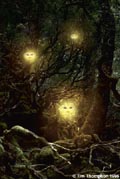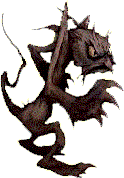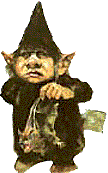|
|
|


Pixies are the pranksters of Cornwall. Some sources attribute their origin to
the Irish saints, while others claim they are souls of virtous pagans. The most
prevalent theory regards them as the gods of pre-Christian Cornwall.
They delight in leading people astray from their paths and leaving them to
wander aimlessly for hours until dropping into a deep sleep, a practice which
spawned the term pixie-led. While pranksters, Pixies were also known to led
helpful hands to humans in need. The elderly might find household tasks
mysteriously complemented, the worthy farmer may discover his grain has been
mysteriously threshed and maidens searching for their true love may beseech his
name by going to a well and pleading with the Piskey folk.
Typically they appear as wisened old men no taller than a hand's span. (In
fact, there is only one reference to a female piskey, Joan the Wad, who is
regarded as their Queen.)


Originally coined by Thomas
Keightley in The Fairy Mythology (1850) from the Irish "Leith bhroyan"
or "Leith phroyan" meaning "one shoemaker," comes the name Leprechaun.
They are also known by the name Gentry. In addition, Jewish folklore
tells of a similar creature, the Sheedem or Shedim. It is now demonized
and the name used derogatorily in reference to pagan deities. Their
typical habitat is wild areas with large grassy hills.
Leprechauns are a race of cobblers whose craftsmanship is beyond compare. As
a result, their wares go for astonishing sums which makes most of them
exceedingly wealthy and is likely the source of the tales of their pots
of gold. Infamous hoarders, they are loathe to spend a single penny,
which probably explains their poor appearance in spite of their great
wealth. Some legends says that once a leprachaun begins dancing to a
human's song, he cannot stop until the tune ceases. His exhausted state may cause him
to make outlandish offers, including his crock of gold, if you will
please only allow him to stop dancing. Other means of finding his gold
include looking at the end of a rainbow, which may lead him offer 3 wishes
in exchange for his treasure. His promises of gold alway proves hollow, as the Leprechaun
always employs clever tricks in his granting of wishes, often resulting
in the embarrassment or injury to the one who expected a bounteous reward.
Green is the color of choice among this race, though their clothing
is never extravagant. Their footwear, however, is a source of pride
and every Leprechaun posses the very finest he can make. Their clientele
is exclusively faery and legend holds that they only make one shoe at a time,
never pairs.
Apparently, the race is exclusively male as no female Leprechaun have
ever been seen.
Some Leprechauns belong to the unseelie court; they are raiders of
wine cellars who revel drunkenly after dark riding the backs of sheep
or shepherd's dogs. The name cluricauns (kloor-a-kawns) is applied
to the dark members of the family. Cluricauns often favor red clothing
to set themselves apart from the seelie Leprechauns.
Master and Man (A story of a Cluricane)
The origin of this race
is traced to Scotland. Brownies currently residing in the United
States and Canada most likely arrived with Scottish immigrants.
Among their names from other human cultures are: Nis from Denmark,
Domonvoi from Russia (where they cry like Banshees when death is
appraching a member of their chosen family, and to warn of fires),
Yumboes from North Africa, Choa Phum Phi from China and Hobs from
the English. They are still common to the Scottish Highlands and
on the Hebrides Islands, but are rarely heard of elsewhere.
Brownies are domestic faeries, offering aid to mortals who are churning butter or
grinding meal. For their service, they expect rewards of milk and
bread. (Brownies who are displeased with
their gifts often turn into the nasty Boggarts who harass the
inhabitants of their domicile.) As with other faeries, should a
human mistakenly offer them clothes in return for their labors,
brownies will cease their efforts and disappear forever. In addition
to their labors in the home, some brownies also guarded the corn yard
during winter. Because of their industrious and beneficial nature,
the Girl Scouts have adopted the name Brownies for their youngest
members.
Resulting from their generous nature, a hatred of misers and
cheats is characteristic among the race. Brownies will not tolerate
lying and utterly detest pretentiousness.
They are nocturnal, although most are able to appear in the sunlight
should they wish. However, there are a few non-Scottish House brownies
who will perish if exposed to sunlight. Legends holds that it is for
this reason that the brownies' familar, the rooster, crows in the
morning, warning his friends that it is time for bed. (Some Scots
even held that brownies could take the form of roosters.)
Small and usually male, brownies tend towards the hairy side and
have slightly pointed ears, long fingers and dress in blue, green
or the most typical brown. Their size makes them extremely cautious
of cats and the humans they assist must not harbor the beasts within
their homes. Most are keenly intelligent, except the Dobie who is a dull
witt. He wishes to help, but always flubs the job because of his lack
of intelligence.
Orginiating in Scandinavia
(though Scotland is the source for most North Ameridcan lore), Gnomes later
migrated to the 'low lands' some 1,500 years ago. As a species, they
are 7 times stronger than humans. Another of their unique
characteristics, Gnomes are always born as a set of twins. Leading
nocturnal lives, they rarely come into contact with humankind.
Gnomes are very widespread species, known to a number of human races.
Germans name them Erdmanleins, except in the Alpine areas, where they
are called Heinzemannchens. In Denmark and Norway the are Nisse; Nissen is
Swedish variation. In Brittany they are called Nains. Tontti to the
Finns and Foddenskkmaend is their name in Iceland. The Polish call
they by the familar Gnom. Bulgaria and Albania, however, use Dudje.
In Hungary, Yugoslavia, and Czechoslovakia, Gnomes are called Mano.
The Dutch use Kabouter and the Belgian, Skritek. Switzerland and Luxembourg
use the same name, Kleinmanneken, which means "littlemen." Domovoi Djedoes
is used in western Russia, translated it roughly means "earth faery."
Largely due to the her choice of garb, the domain of the
female gnome is the home and thus it is with the male that
almost all human contact occurs. Females wear either gray
or khaki colored clothing consisiting of a blouse, an ankle
length skirt, knee socks and high shoes or slippers. (The
color combination results in a possibility that she may be
mistaken for a mouse or other small forest animal and be
captured by an owl before he realized his mistake.) Prior
to marriage, the outfit is complemented by a green cap and
braids which later disappear under a scarf while the green cap
is replaced by more somber tones after she marries.
Male Gnomes wear red caps and blue smocks complemented by
green pants and footwear. They are fair of face, though the
boast rosy red cheeks. Long beards adorn their faces and turn
gray far sooner than their hair. Males are the guardians of
animal kind and show little preference for their animal friends,
not withstanding their aversion to cats both wild and domesticated.
They are known for freeing wildlife from man's traps and for
operating on farm animals whose owners have neglected them or
who are simply to poor to afford a vetrinarian.
Gnomes consist of a number of different types. The most common
is the Forest Gnome who rarely comes into contact with man. The
Garden Gnome lives in old gardens and enjoys telling melancoly
tales. Dune Gnomes are slightly larger than their woodland
breathren and choose remarkably drab clothing. House Gnomes have
the most knowledge of man, often speaking his language. It is
from this family that Gnome Kings are chosen. Farm Gnomes resemble
their House brethen, but are more conservative in manner and dress.
Siberian Gnomes have been more interbred than other Gnomes and
associate freely with trolls. They are much larger than the other
types and have an infinately more nasty nature. It is best never to
evoke the ire of such Gnomes for they delight in revenge.
For more information, I recommend the following site: Gnomes
The Will-o-wisp is among
the most named faeries, travelling with countless aliases. Among the
Cornish names are Faery lights, St. Elmo's Fire, Jack-o-Lantern,
Bob-A-Longs and Jenny Burnt-Tail. The Shetland and Orkeny Islands
use Teine Sith (meaning Fire Faery), the Germans 'Huckpoten,' the
Swedish Irrbloss, the French Eclaireux, the Italians Candelas and the
Russians Ruskaly.
They typically appear as a grouping of tiny flickering lights,
almost like fire flies. Flickering and wavering, the glowing orbs
move through marshes, meadows and grassy hills at the hours just
after sundown.
Some believe the lights to be the glow of actual faeries, while
others argue they are merely torches and lamps carried by the fae as
they revel. Whatever they are, humans who glimpse and follow the
lights experience something likened to a game of tag as they disappear
everytime the distance between the pair closes too much. Those who
follow them successfully, though, have claimed to witness gatherings
of faeries as they hold their nightly celebrations.
Hordes of information has
been written on the Green Man, yet he still remains somewhat of a
mystery. The name typically applies to an ancient deity whose
likeness has been carved into older churches across much of the
British Isles. Typically it is a composite image of a face formed
for a mask of leaves or a face devouring vines and leaves. The
image's meaning is typically one of life, renewal and rebirth, and
inspiration. He is a personification of the union between mankind
and nature. His association with churches is likely an instance of
pagan gods being absorbed into Christianity to entice converts or to
make their worship safe.
The Green Lady is sometimes named as female counterpart of the
Green Man. Some consider her a pagan worship form of the Virgin
Mary. Others dispute her existence. At the very least, the image
is not as old as that of the Green Man.
Robin Hood is considered by some scholars to be one of the many
incarnations of the Green Man. In this case, it is the ancient
legend of the King of the Wood whose lady was named Marion. It
was to this older and more powerful figure that the story of Robin of
Locksley was eventually grafted. The Green Man is also connected to
Robin Goodfellow and Puck, as well as Jack the Green who dances ahead
of the May Queen in May Day parades.
The Irish Ballybogs, known as bogles among the Cornish and Welsh and
Boggans among those residing in Northern England, are also called Peat
Faeries, Mudbogs, Boggies and Bog-a-boos. The reoccurrence of the
word bog in their name harkens to their typical habitat: peat bogs
and mudholes. They were most typically encountered in Ireland, where
people uesd peat as a main source of fuel because Ireland lacks
natural coal and oil deposits.
Their appearance of the very small creatures was decidedly
odd. Mud-covered, almost completely round bodies, supporting heads
without the benefit of a neck. Their arms and legs were long and
spindly; apparently too much so to support their weight. Ballybogs
possess no language, but rather communicate with grunts and slobbering.
While the Irish Ballybog was merely unpleasant, the English
Bogle possesses a nasty temper. The Bogle focuses the majority of
its ill will upon those who are lazy, incontinent, or guilty of
crimes. Like many of the fae kind, both manifestations enjoy leading
unwary travelers astray.
It is believed that at one time, they were they guardian
spirits of bogs. Some have suggested that the preserved human
remains found in the peat bogs of northern Europe are evidence of
ritual human sacrifices made to placate the fae who dwelled within
the bogs.
Some legends say Boggarts
are brownies that have gone bad. Either because they are mischevious
in nature or because they were wronged through some interaction with
humans. Others tell that they are merely small dwarfish cousins of
the brownies. Their origin is traced to Scotland where they are also
known as Hobgoblins, the Boogey Man, Boogies, Padfoot, Boggans,
Hobbers, Gobs and Blobs. The root of the name, 'bog' may indicate a
relation to the ballybogs as well.
They are always of the male persuasion (apparently female brownies
have better sense than to turn bad). Whatever their relation to the
gentle brownies, boggarts have vastly different intentions. They
delight in playing tricks on humans. Rather than adopting a home to
help its human inhabitants, boggarts will enter a home with one thing
on their minds: destruction. The favorite food of a boggart is
smooth wood and a home they have chosen as their residence provides
not only shelter, but also their sustenance! Boggarts also pose a
threat to children, as they love to steal their food and try to
smother the young humans as they sleep at night. Should your home
be infected with a boggart a complete exorcism may be necessary to
rid your abode of the pest. Others are completely dim-witted and can
be tricked into leaving a home. One of the best ways to do this is
to ask the boggart to leave the house and stay out as long as 'the
hollies are green'. It will mostly likely take at least two seasons
for him to remember that hollies are always green and that he's been
tricked. His resulting anger most likely needn't be feared as he
will never be able to enter the house again.
The moral here is that it is best to stop boggarts at their
source: never anger a brownie!
Brownies

Gnomes


Will'o'Wisp

Green Man
![]()
Ballybogs

Boggart

Unimplemented ISML Tag: TYPE=
